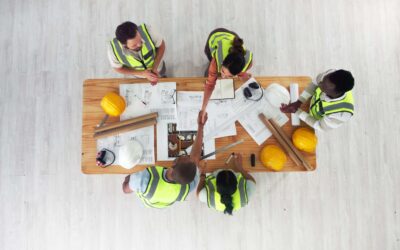Blueprint for Success: Navigating the Design-Build Market
The Design-Build Market is Predicted to Exceed $500B, According to New Study
FMI Consulting and the Design-Build Institute of America (DBIA) recently released the 2025 “Design-Build Utilization Study” on the state of design-build. This report delves into the nonresidential design-build market size, direction, trends, and drivers. The survey findings offer valuable insights tailored for owners, designers, and contractors deeply involved in design-build, detailing the reasons behind owners’ preference for design-build and highlighting the anticipated expansion in market sectors.

Sizing the Design-Build Market
Overall, FMI predicts that the design-build market will continue to grow as a share of overall US construction put in place each year. They anticipate national spending will exceed $500 billion per year with a steady Compound Annual Growth Rate (CAGR) of 2.9%. Here in the “South Atlantic” region, encompassing states along the Atlantic Seaboard from Maryland to Florida, the report predicts that design-build market will grow to $112 billion by 2028 with a 2% CAGR.
This growth isn’t spread evenly across all vertical markets. While large sectors like Manufacturing (totaling $100 billion) are experiencing a decline of -1.8% CAGR, Educational projects (amounting to $68 billion) are showing promising growth at a rate of 4.1% CAGR. Commercial projects, valued at $65 billion, are following a steady growth path with a CAGR of 2.1%.
Other major growth markets include Highway and Street ($87B, 4.8% CAGR), Transportation ($41B, 6.1% CAGR) and Water/Wastewater ($41B, 7.8%)
Why Owners Select Design-Build
FMI writes that “design-build is rapidly becoming a preferred project delivery method across various project types and sizes.” They attribute this growth in the design-build market to several factors:
- “Moving away from adversarial attitudes fosters trust and efficiency, while early contractor involvement mitigates risks and accelerates timelines.”
- “Design-build is most advantageous for projects with high complexity or critical schedules”
- “It streamlines communication and accountability by integrating the design and construction teams early, allowing for better handling of complex coordination, risk management, and decision-making.
One respondent summed up how design-build helps them manage risk:
“In traditional Design/Bid/Build, you aren’t sure of the project cost until it is done. These days especially, you’re going to be over budget most likely. The cost of disputes and litigation on more traditional delivery methods is higher in general. With more use of progressive design – build, you can have some of the cost certainty early in the project and fewer disputes, which results in overall lower costs.”
Design-build is growing nationwide, with owners pointing to several reasons why it helps them reduce risk, lower costs, and speed up schedules. However, they also identified several barriers to implementing design-build in their area, which we will cover in our next blog post.
Let’s start the conversation today on how the design-build approach will enable you to elevate your project.
Maximize North Carolina’s design-build process to fast-track projects and drive innovation with expert guidance.
Ready to explore the advantages of design-build for your projects?
Related Blogs
How Design-Build Drives HUB Participation
Design-build project delivery enables greater participation by Historically Underutilized Businesses (HUBs) by emphasizing early engagement, flexible collaboration, and values-driven procurement. This approach helps owners move beyond compliance to create more innovative, inclusive, and successful projects.
Top 3 Barriers to Successful Design-Build Implementation—and How to Overcome Them
Design-build is on the rise, but many owners still face real-world challenges that can derail project success. In this blog post, we break down the top three barriers to effective design-build delivery—based on findings from the 2025 Design-Build Utilization Study by FMI and DBIA—and offer practical strategies to overcome them. Whether it’s limited understanding, perceived loss of control, or collaboration struggles, we’ll help you navigate the roadblocks and build stronger, more efficient project outcomes.
The NC Process for Design-Build
In North Carolina, design-build is a proven construction procurement method that fosters collaboration between designers and contractors from project inception. This blog post serves to outline the procedural steps necessary to select a design-builder in alignment with North Carolina regulations, offering insights and best practices for a seamless process.


